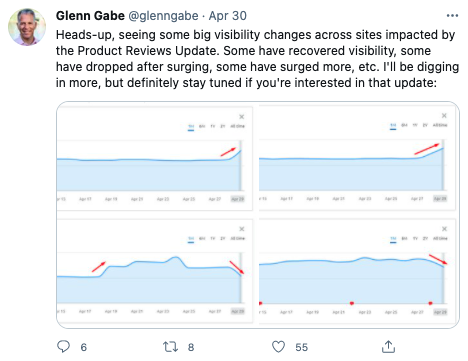Article's Content
Welcome to Volume 30!
If you were to leave a review for this newsletter, what would it say?
If you were to leave the best quality review for this newsletter, what would that look like?
If you were wondering why I ask, it’s not because I’m looking for a review; it’s because product reviews don’t just matter to your prospective customers. They now matter to Google.
Before we get into that, here’s a peek at what’s to come:
- Product reviews matter more to Google than you previously thought.
- Image optimization can be just as crucial as content optimization.
- Google’s search console’s got not one but two updates!

Product Reviews; they aren’t just important to your audience
We create content for our audience and include reviews for their benefit.
We optimize content for Google, but we don’t optimize our reviews for its benefit.
Since it is Google’s mission to provide “the most useful and helpful information possible” for every search, it makes sense that they are looking into reviews.
In the same way, your audience is checking out reviews to identify the best option for them; Google is now checking out reviews to see which is the best product to promote.
This algorithm update rolled out in April, so if you saw your rankings fluctuate – this is why.

For now, this update can only read and understand English reviews, but Google is going to take this learning and expand to other languages in the future.
When it comes to reviews, we know that more is more! And we want to ensure the reviews left are wholesome and in-depth enough to satisfy a lead who entered the bottom of your funnel. No one is looking for, nor will they be satisfied, by a one-liner saying, “this product worked great for me.”
Google is smart enough to know that those one-liner reviews aren’t as helpful as an in-depth research-backed one. The focus of this update is to identify reviews that include insightful analysis and original research, there is no comment on understanding the sentiment of the reviews.
You won’t be directly penalized for having weak reviews on-site, but you will be rewarded by having high-quality reviews on-site. The rewarded sites will indirectly impact your rankings, as they rise above.
In sum, the product review update is designed to reward products that consumers have found helpful because this indicates to Google the product’s strength.
In the press release announcing the update, Google included some questions that you can ask yourself when judging the quality of your reviews.
Do the reviews…
- Show what the product is like physically, or how it is used, with unique content beyond what’s provided by the manufacturer?
- Provide quantitative measurements about how a product measures up in various categories of performance?
- Explain what sets a product apart from its competitors?
- Cover comparable products to consider, or explain which products might be best for certain uses or circumstances?
- Discuss the benefits and drawbacks of a particular product based on research into it?
- Describe how a product has evolved from previous models or releases to provide improvements, address issues, or otherwise help users make a purchase decision?
- Identify key decision-making factors for the product’s category and how the product performs in those areas? For example, a car review might determine that fuel economy, safety, and handling are key decision-making factors and rate performance in those areas.
- Describe key choices in how a product has been designed and their effect on the users beyond what the manufacturer says?
You can always remix this list of questions to ask your audience directly, after their experience, and use those answers to guide review creation.
Key Takeaways
- Product reviews are no longer just for the benefit of your audience.
- Sites won’t be penalized for weak reviews, but sites will benefit from high-quality reviews.
- You should prompt your audience to answer questions during their reviewing process to gather higher-quality reviews.
It’s time to optimize onsite images
PSA: If you change your image URLs and you care about Image Search, remember to redirect them. – John Mueller, May 1, 2021.
Google Image search is just as fruitful for driving traffic as the typical SERP, depending on what you’re sharing. Many sites rely on Google Image search results to drive traffic. Think about all your beautiful infographics floating around on the image results page 🤔 How can you ensure they are working for you?
If you aren’t sure if you have any images driving traffic to your site, here’s a quick way to check:
- Head to Google’s Search Console Performance Report
- Set “Search Type: image”
- Analyze those results to see if you are driving worthy clicks through to your site 👍

Once you’ve checked out the performance report, you can start to optimize your image content. 👇
Page Speed Index: You want to ensure that your landing pages that include images are optimized for load times. To do so, grab a few landing pages that have popular images, and run them through Google’s Page Speed Insight.

After it’s done analyzing your content, Google will provide you with a report which includes “Opportunities.” And by acting on these on-site, image-optimizing opportunities, your content will begin to be rewarded.
After that initial heavy lift, there are a few more steps to ensure your images are correctly optimized:
- Using “image lazy load,” particularly for images below the fold.
- Making your images the right size so the quality is unaffected.
- Specifying the image size – done through a plugin.
- Properly redirecting all image URLs from old domains to new domains, when applicable.
There is no magic guide to image optimization, but taking these steps should improve your page speed, a core ranking factor.
Key Takeaways
- Optimizing images will benefit your page speed which is a core ranking factor.
- Depending on the nature of your content, images can generate a good portion of your site traffic.
New and improved search console reporting
Although this update didn’t spark controversy, like Google’s bid strategy update did, Google has revamped data filtering and comparison within their Search Console Performance reports.

On April 7, Google added two new improvements to make its reports more useful:
Regular Expression (regex) Filters
Pre-update, we could filter by queries and page URLs based on three patterns: containing a string, not containing a string, and exact match to string. But we weren’t able to dive into more complex cases, for example, a query containing one out of a few optional strings.
Post-update, we’re able to run those more complex searches. It’s easiest explained through an example, so here we go — We work at a company called “SEO & Monetization;” sometimes our brand is referred to as “SEO and Monetization,” or “S&M.” With the regex filter, we can filter down our data to see branded queries based on all three iterations.
… although S&M may not return the branded results we’d expect 😳
Revamped Comparison Mode
Pre-update, the comparison mode worked to display comparison-based reports, but if you had selected more than one metric, the table wouldn’t show a comparison column for the relative percentage difference.
Post-update, comparison mode fully supports cases with multiple metrics selected. And they’ve improved the interface to make it even easier to use when viewing side-by-side results. Plus, it supports the regex filter for queries and pages!
Go forth and report in delight!
Key Takeaways
- Regex will allow you to filter by more complex queries.
- Researching and reporting through Search Console just got better.
- Google’s search console has an improved comparison mode table, including a relative difference in percentage column.
OTHER NEWS OF THE WEEK:
🎮 Sony has announced an investment in and partnership with Discord to bring the chat app to Playstation.
👬 To make connecting with remote team members easier, Gatheround has raised $3.5M in seed funding to help them aggressively enter the market.
🤖 Path Robotics, a company that is automating the world of welding, has raised $56M in their Series B funding round.
BRAIN FOOD OF THE WEEK:
On April 26th, Lyft sold its self-driving unit to Toyota’s Woven Planet for $550M. On April 28th, Uber launched half a dozen new products and features to bolster their “go get” strategy.
Uber sold their self-driving unit to Aurora a while back, so now it’s a battle between ride-hailing apps and which will last in the long term. The focus on the core ride-hailing service sparked Uber’s push to launch new features and differentiate itself from the competition.
Speaking of competition, Revel – the electronic kid on the block – has joined the battle of ride-hailing services. Making its start in e-mopeds in Brooklyn, Revel quickly popped off and is now partnering with Tesla to provide an all Tesla, all-electric, ride-hailing service.
TWITTER THREAD OF THE WEEK:
How to write an engaging blog intro by Chima Mmeje
WHAT WE’RE WIRED INTO THIS WEEK 🎧:
Cut Out by Ralph Castelli (Best Track: Brake Lights)
Originally sent out, by me Cali B, on Thursday, May 6, 2021.
Stay up to date with all of our latest findings by subscribing to our newsletter today. Signing up also gives you early access to Ross’ Tuesday essay full of exclusive industry insights.
Quick, do it now before the next drop!







